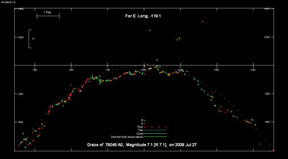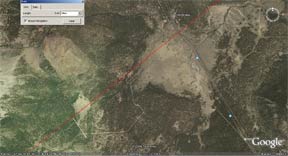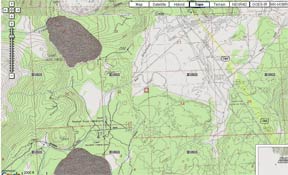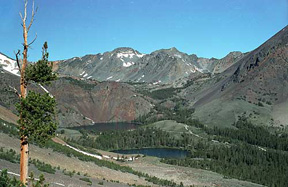Astro 28Y: Field Astronomy At Mono
Lake: Aquarius Meteors and a Lunar Graze
July 25-27, 2008
Post
Trip Photo Page
This Astro 28 installment
will feature not one but two big events - the Delta Aquariid Meteor Shower,
and also a grazing lunar occultation.
 The
Delta Aquariid Meteor Shower. This
shower is caused by debris from an old comet. The parent comet is not known
for sure, but Comet Macholz 96P is the leading candidate. Now, the exciting
thing is, this comet had a major break-up happen in the mid '90's, freeing up
vast amount of cometary dust and pebbles. The orbital period is only a little
over 5 years, and so its possible the strength of this shower will be increasing
in coming years. In the past, this shower produces about 20 meteors per hour
at maximum July 28. The shower is active from mid July to mid August.
The
Delta Aquariid Meteor Shower. This
shower is caused by debris from an old comet. The parent comet is not known
for sure, but Comet Macholz 96P is the leading candidate. Now, the exciting
thing is, this comet had a major break-up happen in the mid '90's, freeing up
vast amount of cometary dust and pebbles. The orbital period is only a little
over 5 years, and so its possible the strength of this shower will be increasing
in coming years. In the past, this shower produces about 20 meteors per hour
at maximum July 28. The shower is active from mid July to mid August.
There are other meteor showers active
in late July - probably the most active meteor shower period of the entire year.
We also have the (weak) Capricorniids
peaking about July 31, the first of the spectacular Perseid
Meteor Shower members will also be arriving, the iota Aquariids,
the northern Delta Aquariids (a separate but likely related shower) are also
active. We'll have great fun disentangling the meteors from these several showers!
All of these showers are made of bits of comet rock no bigger than a grain of
sand (usually), or maybe a pebble for the bright ones, burning up and ionizing
our atmosphere as they enter at 140,000 feet per second 40 mile above our heads.
How to Observe Meteors? This
is the Fun Part...
We'll set up a circle, each of us
snug in our sleeping bags, hot chocolate mug nearby. We'll focus on the sky
and report each time we see a meteor. I'll help you with identifying the shower
that it came from, or if it's instead a rogue "sporadic". Check out
the data we gathered and sent off for scientific analysis on last summer's version
of this trip - Astro 28V.
The radiants come up late, Good counts shouldn't be expected much before midnight.
And - A
Lunar Grazing Occultation
As morning dawn begins to brighten
the sky on Sunday morning, a bright 7th magnitude star will graze the northern
edge of the 30% sunlit cresent moon. These events are spectacular to watch,
as the star glides over the ghostly earth-lit polar regions of the moon, blinking
on and off as it passes behind silhouetted mountains and canyons on the edge
of the moon. I'll have a video recorder setup on our 10" scope and make
a movie of the event. Go-getter students will man nearby "stations"
(if they can pack one our scopes into their car) and we'll be able to assemble
a profile of the mountains and compare to the predicted profile. Our data will
then be reported and become part of the data base used to keep accurate and
refined measures of the orbit of the moon. It is still the most accurate way
we have of determining the exact changes in the orbit of the moon. In order
to see this, we must position ourselves carefully. The lunar
profile for the graze is here. And the predictions
are here.

The northern edge of the moon (vertical
scale expanded 20x) . The star will drift from left to right during
the few minutes of the graze. Trust me - this is a beautiful profile,
promising many D's and R's and a great show for us.
|

The perfect location to see the best graze
is 0.5 miles south of the 7800 ft elevation TanZ limit line (red, on
this Google Earth map). Our good luck - Lower Deadman Campground is
exactly there. We'll camp on a Sierra creek amid the pines, and not
have to drive to see the graze.
|
|
|
Our Campsite
 We
have the good luck to have a campground which is exactly in the right location
to observe the
We
have the good luck to have a campground which is exactly in the right location
to observe the  Sunday
morning graze without having to drive. It's lower Deadman
Campground. It's located on Deadman Creek (headwaters of the Owens
River), a few miles south of June Lake, and an easy 2 mile drive along forest
service roads west of Hwy 395. There's no reservations and it's a summer weekend,
so there may be competition for campsites. Hopefully we'll get there early enough
on Friday to grab all we need. It's got restrooms, tables, but no spigots. We
can use the creek water for cleaning and washup, and plan to bring your own
water for drinking. We'll have opportunities during Saturday's excursions to
stop and refill water bottles etc. When you arrive, my goal is to camp on the
south side of the creek, as shown on the terrain map at right. That location
is exactly 0.50 miles south of the graze limit line.
Sunday
morning graze without having to drive. It's lower Deadman
Campground. It's located on Deadman Creek (headwaters of the Owens
River), a few miles south of June Lake, and an easy 2 mile drive along forest
service roads west of Hwy 395. There's no reservations and it's a summer weekend,
so there may be competition for campsites. Hopefully we'll get there early enough
on Friday to grab all we need. It's got restrooms, tables, but no spigots. We
can use the creek water for cleaning and washup, and plan to bring your own
water for drinking. We'll have opportunities during Saturday's excursions to
stop and refill water bottles etc. When you arrive, my goal is to camp on the
south side of the creek, as shown on the terrain map at right. That location
is exactly 0.50 miles south of the graze limit line.
I'll have detailed maps which help
you navigate from Santa Cruz over the Sierra to our campsite when I see you
on our on-campus meeting. I'll also have fee waivers so you can drive into and
through Yosemite without paying the usual $20 fee. Nice!
Planetary Science Adventures
During Saturday
We'll have micro-lectures throughout
Saturday as we caravan around the area, studying some of the youngest volcanic
features in North America, including Pahnum Crater, volcanic faults near Mammoth
Lakes, and the Black Point eruption site north
of Mono Lake.
with it's beautiful tufa formations.
 Recently, it was discovered that there was a large comet impact hitting North
America just 13,000 years ago. This coincides with the date of the Black Point
volcano eruption on the north shore of Mono Lake. With new information, I'd
like to lead a hike up a nearby creek to search for the tell-tale dark layer
of burned material left from the cataclysm. That would be a great find, scientifically,
since so far there are no published mention of this layer in mainland California
(but also no reason it shouldn't be here! No one has looked - the discovery
is quite new).
Recently, it was discovered that there was a large comet impact hitting North
America just 13,000 years ago. This coincides with the date of the Black Point
volcano eruption on the north shore of Mono Lake. With new information, I'd
like to lead a hike up a nearby creek to search for the tell-tale dark layer
of burned material left from the cataclysm. That would be a great find, scientifically,
since so far there are no published mention of this layer in mainland California
(but also no reason it shouldn't be here! No one has looked - the discovery
is quite new).
We'll
drive another 30 miles north of Mono Lake to study and enjoy the famous hot
springs around Bridgeport, including Buckeye
Hot Springs, Travertine
Hot Springs, and Fales Hot Creek all just a few miles from each
other. See pictures of the Bridgeport area hot springs from last year's
Astro 28S class. And the general Mono Lake / Yosemite area was
the subject of a recent
Image Quest Photo Workshop on which I helped crew.
As a backup in case the regular campgrounds
are all full (not likely), we'll head for the camping area along Virginia
creek in an open meadow near Virginia Lakes, high above the spectacularly
scenic aspen groves of Conway Summit above Mono Lake and just below the Sierra
Crest at the boundary of Yosemite National Park. During the day we'll explore
Mono Lake (gulls and other birds love this lake for breeding and as a way station
during migrations). One advantage of the Virginia Lakes site is that it is higher
in elevation and therefore probably cooler
 Virginia
Lakes (left) are in a picturesque high canyon, and Mono Lake (right) is far
below. Our camping
Virginia
Lakes (left) are in a picturesque high canyon, and Mono Lake (right) is far
below. Our camping  area
would be just off the lower right side of this photo (click for enlarged version).
The canyon sides are steep though, and our view of the sky would not be as good
as at Honeymoon Flats. Below Virginia Lakes is Conway Summit, and its beautiful
stands of quaking aspen, still green in August, but just beginning to change
to yellow in a few higher elevation spots.
area
would be just off the lower right side of this photo (click for enlarged version).
The canyon sides are steep though, and our view of the sky would not be as good
as at Honeymoon Flats. Below Virginia Lakes is Conway Summit, and its beautiful
stands of quaking aspen, still green in August, but just beginning to change
to yellow in a few higher elevation spots.
(Conway aspen photo: copyright Doug Broussard. All Rights Reserved)
The Plan
Friday July 25
Arrive as soon as you can to the campsite. It's about a 6 hour drive, depending
on traffic. I should arrive in the late afternoon. Set up your tents, group
kitchen area. We'll cook dinner before dark.
8:30pm - 10:30pm: Lecture around the telescopes. We'll study
the star formation regions of the Sagittarius Spiral Arm, the distribution of
giant globular clusters, the dark nebulae (including the famous "Dark Horse"
nebula), and the planet Jupiter and its moons amid the Milky Way star fields.
10:30-12:30am: We'll set out our sleeping bags and do meteor
counts while munching sweets and whatever other nasty stuff you guys bring along.
I'll show you how to log your counts.
Saturday July 26
7:30am: I'll get up and begin preparing the batter for our
French Crepes breakfast. Figure on eating at 8:30am. Late risers beware. Snooze/lose!
9:30am: We consolidate into a few cars and begin our adventures.
First stop will be Mono Lake north shore and the Black Point volcanic formation
and Wilson Creek. We'll hunt for the Black Point ash layer and search for the
Pleistocene impact layer. Will we find it? Who knows - but we won't find it
if we don't look. I'll have specimen bags and labelling. If anyone's got a good
microscope that doesn't need power, bring it along to camp so we can take a
look later Saturday night.
Noon. Head north to Bridgeport and Buckeye Hot Springs - my
favorite hot springs of the Sierra. Enjoy a Native American hot/cold contrast
session as the hot springs is right on Buckeye Creek. Then, drive back to Bridgeport
and Travertine Hot Springs for lunch. Lecture on planetary science, plate tectonics,
the geologic history of California, and ending with the story of hot springs
formation and prospects on other planets.
3pm - Stop at Mono Lake (either the north shore county park
with nice lawns and shade trees, or the more dramatic but stark South Shore
tufa reserve).
5pm - Hike to Pahnum Crater on the south shore and it's amazing
black glass formations. You'll swear you're on the moon. Search for artifacts.
We found an arrowhead last time. Lecture on Long Valley caldera and its history
7:30pm - Return to camp and fix a dinner of Asian rice and
veges. If we're early enough, we (you?) can do a short hike over to a giant
BLISTER on our planet - an obsidian dome.
9:30pm - 10:30pm - Telescope session and lecture on cosmology
10:30-Midnight. Meteor counts
Sunday July 27
4am - Up early to observe the graze, (then quickly go back
to sleep!)
8:30am - late breakfast of eggs and veges and fruit.
9:30am - pack up camp and drive to June Lake - it's just a
couple miles off Hwy 395 on the way back home - and do a swim and final lecture,
as well as summarize the lunar graze results. Hand out the final exam, and say
our farewell's.
During the day, we'll study the local
geology and lecture on the history of the earth and the inner solar system,
with special emphasis on the geologic history of the Sierra / Basin & Range
boundary region in which we'll be camping. I'll be treating you to my famous
French crepes breakfast on our first morning, and cooked eggs and/or veges on
the second morning. I'll also be providing dinners of pasta and other delicacies.
Maps, academic handouts, and carpooling will be handled on our pre-trip meeting
in August just before the weekend trip. Click below for the details. Here is
the planetary science hand-out
which I'll be distributing once I see you at camp. Check out some of the locations
we'll be seeing by viewing my Astro
30 webpage
Google terrain map of Wilson Creek and
north Mono Lake
Google terrain map of Bridgeport hot springs
area
Google terrain map of Pahnum Crater
Grading
Your grade will be based on two components.
(1) A take-home written final exam. You'll have 10 days to complete and mail
in or drop off. and (2) your demonstrated curiosity, participation, and helpfulness
during the get-togethers during the field trip. Fun is an essential ingredient
to any good learning experience! Please take note - your full participation
in all group activities (lectures, hikes, excursions) is required in order to
receive a passing grade. There have been times in the past when students have
wanted to go off and do their own thing. I'm not fond of "herding cats"
and so don't make a big deal out there in the field. But you will not pass the
class if you don't stay with the group.
Camper's Checklist
Back to Rick's HomePage
 The
Delta Aquariid Meteor Shower. This
shower is caused by debris from an old comet. The parent comet is not known
for sure, but Comet Macholz 96P is the leading candidate. Now, the exciting
thing is, this comet had a major break-up happen in the mid '90's, freeing up
vast amount of cometary dust and pebbles. The orbital period is only a little
over 5 years, and so its possible the strength of this shower will be increasing
in coming years. In the past, this shower produces about 20 meteors per hour
at maximum July 28. The shower is active from mid July to mid August.
The
Delta Aquariid Meteor Shower. This
shower is caused by debris from an old comet. The parent comet is not known
for sure, but Comet Macholz 96P is the leading candidate. Now, the exciting
thing is, this comet had a major break-up happen in the mid '90's, freeing up
vast amount of cometary dust and pebbles. The orbital period is only a little
over 5 years, and so its possible the strength of this shower will be increasing
in coming years. In the past, this shower produces about 20 meteors per hour
at maximum July 28. The shower is active from mid July to mid August.



 Recently, it was discovered that there was a large comet impact hitting North
America just 13,000 years ago. This coincides with the date of the Black Point
volcano eruption on the north shore of Mono Lake. With new information, I'd
like to lead a hike up a nearby creek to search for the tell-tale dark layer
of burned material left from the cataclysm. That would be a great find, scientifically,
since so far there are no published mention of this layer in mainland California
(but also no reason it shouldn't be here! No one has looked - the discovery
is quite new).
Recently, it was discovered that there was a large comet impact hitting North
America just 13,000 years ago. This coincides with the date of the Black Point
volcano eruption on the north shore of Mono Lake. With new information, I'd
like to lead a hike up a nearby creek to search for the tell-tale dark layer
of burned material left from the cataclysm. That would be a great find, scientifically,
since so far there are no published mention of this layer in mainland California
(but also no reason it shouldn't be here! No one has looked - the discovery
is quite new). 
 area
would be just off the lower right side of this photo (click for enlarged version).
The canyon sides are steep though, and our view of the sky would not be as good
as at Honeymoon Flats. Below Virginia Lakes is Conway Summit, and its beautiful
stands of quaking aspen, still green in August, but just beginning to change
to yellow in a few higher elevation spots.
area
would be just off the lower right side of this photo (click for enlarged version).
The canyon sides are steep though, and our view of the sky would not be as good
as at Honeymoon Flats. Below Virginia Lakes is Conway Summit, and its beautiful
stands of quaking aspen, still green in August, but just beginning to change
to yellow in a few higher elevation spots.